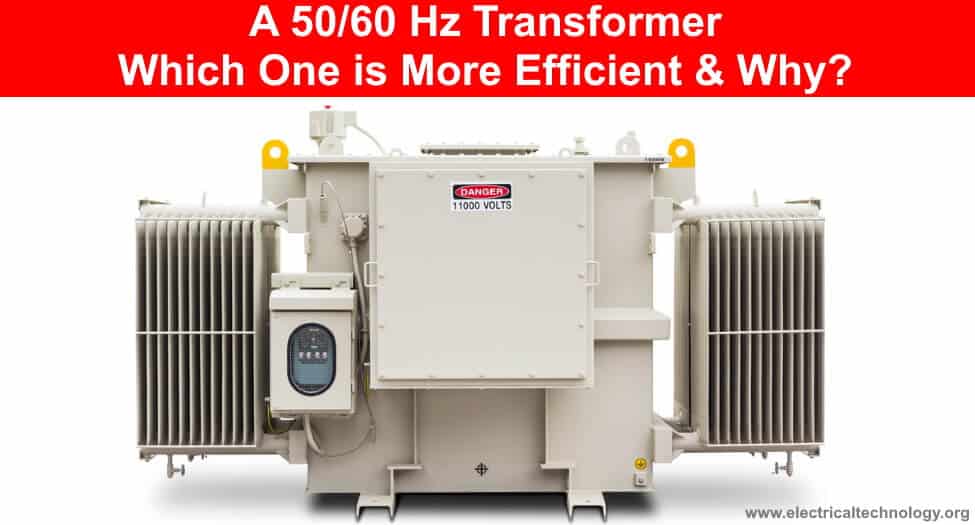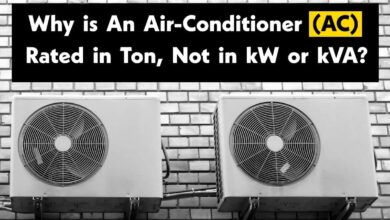Which Transformer is More Efficient When Operates on 50Hz or 60Hz?
A 50/60 Hz Transformer – Which One is More Efficient and Why?
A transformer is designed to be operated on both 50Hz and 60Hz frequency. For the Same rating, which one is more efficient when:
- Operates on 50 Hz
- Operates on 60 Hz
Obliviously! If the rating and parameters of the transformer is same in both cases, a 50Hz transformer is more efficient then 60Hz transformer.
How? Lets do some calculations.
In previous posts, we showed that in an inductive circuit, when frequency increases, the circuit power factor decreases. Consequently, the transformer output decreases.
Let’s consider the following example.
Transformer Rating & Parameters
- kVA Rating = 100kVA
- R = Resistance = 700Ω
- L = Inductance = 1.2 H
- F = Frequency 50/60 Hz
Related Post: Can We Operate a 60Hz Transformer on 50Hz Supply Source and Vice Versa?
When Transformer Operates on 50 Hz Frequency
We are interested in the power factor. So lets find it by “Cos θ = R/Z” where Z = Impedance which depends on Inductive Reactance “XL“.
Inductive Reactance XL = 2πfL
XL = 2 x 3.1415 x 50 Hz x 1.2 H
XL = 377 Ω
Impedance = Z = √ (R2 + XL2)
Z = √ (7002 + 3772)
Z = 795 Ω
Power Factor = Cos θ = R / Z = 700/795
Cos θ = 0.88
Transformer Output (Real Power)
kW = kVA x Cos θ
kW = 100kVA x 0.88
kW = 88000 W = 88kW
When Transformer Operates on 60 Hz Frequency
The same transformer is now connected to the 60Hz frequency. We will do the same calculation as above for 50Hz transformer.
Inductive Reactance XL = 2πfL
XL = 2 x 3.1415 x 60 Hz x 1.2 H
XL = 452.4 Ω
Impedance = Z = √ (R2 + XL2)
Z = √ (7002 + 452.42)
Z = 833.5 Ω
Power Factor = Cos θ = R / Z = 700/833.5
Cos θ = 0.839
Transformer Output (Real Power)
kW = kVA x Cos θ
kW = 100 kVA x 0.839
kW = 83900 W = 83.9 kW
- Related Post: What is Motor Efficiency & How to improve it?
What is the Difference ?
The power factor is higher of 50Hz operated transformer then 60Hz transformer. Now see the difference in transformer output (in Watts i.e. Real or Active Power)
- Output of the 100 kVA Transformer when operated on 50Hz Supply Frequency = 88kW
- Output of the 100 kVA Transformer when operated on 60Hz Supply Frequency = 83.9kW
88kW – 83.9kW = 4100 W = 4.1kW
It may looks small amount of wattage but If we do the same (as above) for the power transformers with high rating i.e, for 500 kVA or MVA Transformers, the result may be huge as shown below.
Suppose everything is same as above, without frequency
Power Transformer Output in Watts When operates on 50 Hz.
kW = kVA x Power Factor (Cos θ)
kW = 500 kVA x 0.88 = 44000 W = 440 kW
Power Transformer Output in Watts When operates on 60 Hz.
kW = kVA x Cos θ
kW = 500 kVA x 0.839 = 419500 = 419.5 kW
Difference in Real Power i.e. in Watts
440 kW – 419.5 kW = 20500 = 20kW
The above calculation shows that a 50Hz transformer is more efficient with high output power as compared to the 60Hz transformer when the rating and parameters of the transformer is same and there is no insulation problems. In addition, if T/F is not designed to be operated on both 60 and 50 Hz, the more current will flow in case of 50Hz transformer with leads in higher power loss due to “I2R losses”. This is due to the the following reasons:
- When frequency (f) decreases, Inductive reactance (XL) decreases (XL ∝ f).
- When Inductive reactance (XL) decreases, Impedance (Z) decreases (Z ∝ XL).
- When Inductive reactance or Impedance decreases, Current increases (XL ∝ 1 / I where I ∝ I / Z).
If a transformer is not designed for both 50 and 60 Hz frequencies as the supply frequency in US is 60Hz while in EU etc are 50Hz, then:
- When a 60Hz transformer is being operated on 50Hz supply source, it should be derated i.e. the supply voltage must be reduced by 1/6 to reduce the peak flux in the core and reduce the heat as well.
- When a 50Hz transformer is being operated on 60Hz supply source, the applied voltage should be 20% increased if there is no problem in insulation.
Again, 50Hz transformer has higher output efficiency than 60Hz transformer with same rating.
Related Posts:
- Is it Possible to Operate a 50Hz Transformer on 5Hz or 500Hz Frequency?
- Can We Replace a 110/220 Turns Transformer with 10/20 Turns?
- Why Transformer Does not Work on DC Supply instead of AC?
- Why Current Increases When Capacitance Increases or Capacitive Reactance Decreases?
- Why Current Decreases When Inductance or Inductive Reactance Increases?
- In a Capacitive Circuit, Why the Current Increases When Frequency Increases?
- In an Inductive Circuit, Why the Current Increases When Frequency Decreases?
- Why Power Factor Decreases When Inductance or Inductive Reactance Increases?
- Why Power Factor Decreases When Capacitive Reactance Increases or Capacitance Decreases?
- Difference Between Single Phase and Three Phase Transformer
- Difference Between Ideal and Real or Practical Transformer








50Hz transforme is more efficient than 60Hz transformer, because iron losses of this transforme is less than 60Hz transforme.
Definitely 50 Hz becz frequency is inversly praportional to leakage flux
Sir, please explain transformer can not operate DC but when testing of done by the DC why?
Prabhakar g, DC is used for testing the insulation strength of winding and lamination only.
How the change in frequency affects the operation of a single-phase transformer?
When frequency increases the impedance also increases so the current decreases and vice versa.
If 60Hz transformer is to be operated on 50Hz, its applied voltage must also be reduced by 1/6 or the peak flux in the core will be too high. This reduction in applied voltage with frequency is known as derating.
Similarly, a 50Hz transformer may be operated at a 20% higher voltage on 60Hz if this action does not cause insulation problems.It is likely the failure of insulation of winding takes place.
Thank you for clarifications.
Hello, by reading all this great explanations, my question is :
is it OK by using an existing down transformer inverse, like is done in so much cheap inverter designs ?
Because its original primary 230Vac windings is rather small in wire gauge diameter,
the original secondary with lower voltage can deliver more current, so has thicker wire gauge.
And than one is inversing this transformers’ use,
but now the primary still has rather small wire gauge (when not proper re-wound)
I am just wondering, and hope on some clarigying answer from the more experienced,
best geragds, Harry.